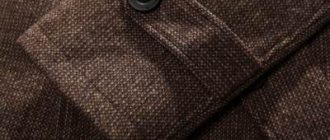Features of washing jeans by hand
In order for jeans to maintain a presentable appearance for as long as possible, it is necessary to take into account some features:
- The first thing to consider here is the frequency of washing. It is better if this is done less often, since frequent wet manipulations inevitably deform the fabric. Some manufacturers insist on dry cleaning, and hand washing is recommended no more than once every few months. If minor dirt appears, a brush or damp sponge is sufficient.
- But if the jeans are brand new, you need to wash them. This will make them much softer and won't stain your underwear as the excess paint will be removed.
- You can wash jeans by hand without too much compression. In extreme cases, if there is heavy soiling, you can use a clothes brush and wash the dirty areas.
- Jeans that are too long should only be shortened after washing, as this process often changes the size.
- The maximum washing temperature for denim is 40 degrees, and very thin items are washed at 30. Too hot water shrinks the jeans and quickly washes out the dye.
- Denim cannot be wrinkled or twisted during the spin cycle, nor can it be thrown over a rope when drying. This way it becomes severely deformed and develops creases.
- Jeans cannot be washed with other fabrics, or with items of different colors.
What can't you do?
Since woolen fabrics are delicate, there are precautions that will help protect them from damage. Here are some recommendations common to all clothing of this type:
- Wool does not tolerate hot water, boiling is also prohibited. In addition, you should not allow sudden changes in temperature during the washing process.
- It is not recommended to soak the material for a long time; the maximum allowable time is 30 minutes.
- You cannot twist, squeeze, stretch, or actively rinse the wool, since under the influence of external force it deforms very quickly.
- The spin speed in the washing machine should be set to the minimum.
- Washing with aggressive detergents is prohibited; low-quality powders and gels should also not be used.
- You cannot pour dry powder directly onto woolen fabric; before use, it must be dissolved in a large amount of water and whipped into foam.
- You cannot dry wool items hanging, that is, on ropes or hangers. Since the fabric does not tolerate high temperatures, it is not worth drying it on a radiator, with a hairdryer or other thermal influences.
- Whether ironing is allowed or not can be found out from the instructions on the label. Some types are tolerant of hot steam, while others may lose their shape and softness.
Water temperature
Wool should be washed at a temperature not exceeding 40°C; washing at 30°C is optimal. If you use hot water, the product loses strength, as a result of which it can shrink, become hard and unpleasant to the touch. Raising the temperature to 60-70°C is permissible only if you need to make a sweater a couple of sizes smaller, but you should do this as carefully as possible.
Detergents
Conventional washing powders are not suitable for materials made from natural wool fibers. It is recommended to use special ones for wool and silk, which prevent caking and do not destroy the structure. However, washing gels marked “For delicate fabrics” are considered more effective and gentle. They promote high-quality removal of contaminants and are washed out better without leaving streaks.
Unfortunately, no powder or gel will help maintain the softness of wool if the water in which the wash is carried out has an increased level of hardness. You can find out by observing how the liquid from the tap behaves when boiling. If scale remains on the walls of a saucepan or kettle, the water hardness is increased. In this case, it is recommended to use softeners and conditioners for washing, which will give clothes softness and freshness. For the same purpose, you can take a 9% vinegar solution. Acid is also suitable for preserving color: pour it into the conditioner compartment if the item needs to be washed in a washing machine, or use it when washing by hand.
Procedure
Woolen items should be washed in the correct order, strictly following the following procedure:
Preparing for washing. Fasten all the buttons and clasps, if any, remove everything from the pockets, and turn the sweater inside out. Removing dirt with a brush. You can clean the wool with a small amount of glycerin heated in a water bath. It is worth considering that the bristle of the brush should be very soft and the friction very weak. Hydrogen peroxide, which should be moistened with a cotton pad, also removes stains well. Soak. This step is necessary if the dry method does not help, there are strong stains left that may not be washed off. You should not soak things for a long time, as staying in water destroys the structure of the fibers. You can leave them in the detergent solution for a maximum of an hour. Wash by hand or using an automatic machine. In the first case, it is easier to control the degree of damage, while the second method requires less time and effort.
It is important to wash no more than 40-45 minutes. Drying. On a horizontal surface at room temperature. Ironing
According to the directions on the product label.
How to prepare jeans for hand washing
Before you start washing your jeans by hand, you need to prepare them for this process. The first thing you should do is read the information on the label: is hand washing possible, what temperature should it be, spin cycle. Second, check all pockets to see if there are any forgotten items. Sometimes even a small detail can ruin a thing. Coin rust or match wax stains are nothing new and can be difficult to remove.
Next, the trousers are turned inside out so that they shed less and your hands are not damaged by metal parts. Jeans are soaked in slightly warm water with a liquid solution to eliminate stains after they dry. This will take no more than an hour.
We recommend reading: How to restore a woolen item that has shrunk after washing
The jeans can then be washed by hand with gel or liquid soap.
General rules
To prevent jeans from fading or becoming deformed, they need to be turned inside out before washing. Before doing this, be sure to check all fasteners (buttons, buttons, zippers). They must be buttoned. Things turned inside out suffer less from contact with the drum. There are no scratches on the metal fittings, and the finishing seams do not wear out.
Stains, if any, must be treated with a special stain remover or improvised means. Decorative leather parts are lubricated with glycerin. It prevents the appearance of small cracks. Pockets are turned inside out and all small change is removed from them.
What you can and cannot wash with
Denim fabric is dense and heavy and can fade, so it is recommended to wash items made from it separately. If the maximum volume of the drum allows, you can put sports T-shirts, trousers, and other items of the same color as jeans along with your trousers.
What detergent to use
The use of regular powder for washing jeans is prohibited, especially with bleach. The fact is that powder granules plant fibers, are poorly washed out and destroy the material. There may also be whitish streaks left. The only way out is to use gel-like products or laundry bar soap.
There are special soft gels for denim on sale. Branded brands often offer their own cleaning products. Thus, the Japanese company Momotaro Jeans offers the composition SZ-001 Jeans Detergent with palm oil extract. This is very economical and aesthetically pleasing, since no more than 30 ml is required, and the item will acquire a delicate peach aroma, which laundry soap cannot boast of. The product itself will look no worse in the second year of wear than on the day of purchase.
Samurai Jeans offers Kaminari Soap. It includes 3 components: water, soybean oil and caustic soda. They hold the color reliably, and the product looks like new even after years of wear.
The packaging of any product contains dosage information. This advice should not be neglected, since this indicator is individual. An overdose leads to poor rinsing and retention of detergent particles in the fabric, and an insufficient amount of the composition does not wash the item.
How to properly wash jeans by hand
After preparing the items and the preliminary soaking stage, they begin to wash by hand.
Washing white jeans by hand is not that easy. Even after soaking, they sometimes remain heavily soiled. The easiest way to deal with them is with a brush. To do this, soap it and carefully wash the places with ingrained dirt: the edges of the legs, pockets. The brush is moved along the denim fibers - this makes it much easier to wash away dirt.
After this, the jeans are turned inside out and the procedure is repeated.
Important! The product should not be rubbed too hard to avoid damaging the fabric.
After this, the jeans are rinsed. The best way to do this is with a shower.
If rinsing is done in a basin, then you need to carry out the procedure 3-4 times. Using gentle pressure, the product is washed out of the fabric, the trousers are turned inside out and rinsed again.
If desired, add fabric softener to the last water. It will make denim softer and more pleasant.
How to properly dry jeans after washing
In order for jeans to retain their good appearance for a long time, it is necessary not only to wash them correctly, but also to dry them. Denim is a rough fabric and does not dry well, which is why many are tempted to wring it out. This cannot be done: such treatment will cause creases and deform the fabric.
Recommended reading: How to remove mold smell from washing machine
Therefore, the jeans are lightly wrung out and hung with clothespins from the belt to the clothesline, and the legs are left hanging. This way the water will drain out and the pants will dry much faster.
You cannot throw your pants over a rope: this will ensure that the wrinkles do not smooth out. This will also cause a long drying time, because in this case the item is folded in a double row.
Another option for proper drying: hook the clothespins to the rope to the edges of the pant legs, and lower the waistband downwards. True, the trousers will take longer to dry, since all the water will run to the belt and pockets, where the double-thick fabric is.
Important! It is best to dry jeans in a draft without direct sunlight.
After drying, the jeans can be ironed on the wrong side with a not too hot iron. If they are dry, you should spray them with water using a spray bottle, or use the steam mode.
Useful tips
It is worth considering the following recommendations:
- Black jeans should be washed by hand at a temperature of no more than 30 degrees without using bleach. Otherwise, after 2-3 washes the fabric will fade and the trousers will become unusable.
- After washing black, dark blue jeans, you need to add a little vinegar to the last water. This will save the color from washing out and give the denim freshness.
- You can add a little oxygen bleach to the water where you wash your white jeans. This will protect the denim from yellowing.
- You need to wash torn jeans especially carefully, since with intensive creasing, specially made holes can be accidentally torn. The same goes for lace and rhinestones: artistic inserts will have to be handled very carefully.
- If your jeans are stretched out, you can use this trick. You need to wash them on yourself: put them on and sit in a bath with 30 degree water. Using a soapy sponge, wipe all areas. Without removing the item, rinse and let dry directly on your body.
As a result, the jeans will fit perfectly, but this can only be done in the hot season.
Preparatory stage
When processing jeans in an automatic machine, many are faced with the problem of shedding, loss of color, and fading. To prevent this from happening, you must adhere to the following recommendations.
First fasten all the fasteners and buttons on your pants. They may come off during processing. Wash them inside out using a special laundry bag. This rule applies to stylish women's models decorated with rhinestones, rivets, and embroidery. This measure will protect the fittings and drum from scratches. Products equipped with metal decor are not recommended to be soaked to avoid rusting.
Wash items with mild detergents designed for denim or colored fabrics. They should not contain bleaches, otherwise after processing you will get a damaged item. The use of a color stabilizer is allowed.
Despite the fact that this material is durable, when washing it, you need to choose a gentle cycle, using a program for denim or delicate fabrics. Some modern automatic machines are equipped with an option for just such things. For processing jeans, it is recommended to choose a temperature of no more than 35-45ºС, and for products decorated with embroidery, glued or sewn elements with a value of 30ºС.
It is recommended to set the spin parameters to a low value, since automatic spinning entails compression of the fibers. This may reduce your trouser size. In any case, the indicator should be no more than 800 rpm, otherwise the item may become deformed or tear.
Drying rules
You already know how to wash jeans in a washing machine, but you need to take the next step – drying – no less responsibly. After the wash cycle is complete, remove the pants from the drum, shake well, straighten and hang upright. Dry the product outdoors in the shade or in a well-ventilated area. Under the rays of the sun, cotton fabric fades and loses its original color.
It is better to avoid drying in a machine drum. After this treatment, the product shrinks. Be careful not to dry out your jeans. It is best to iron them slightly damp, so they will be soft and will not shrink.











